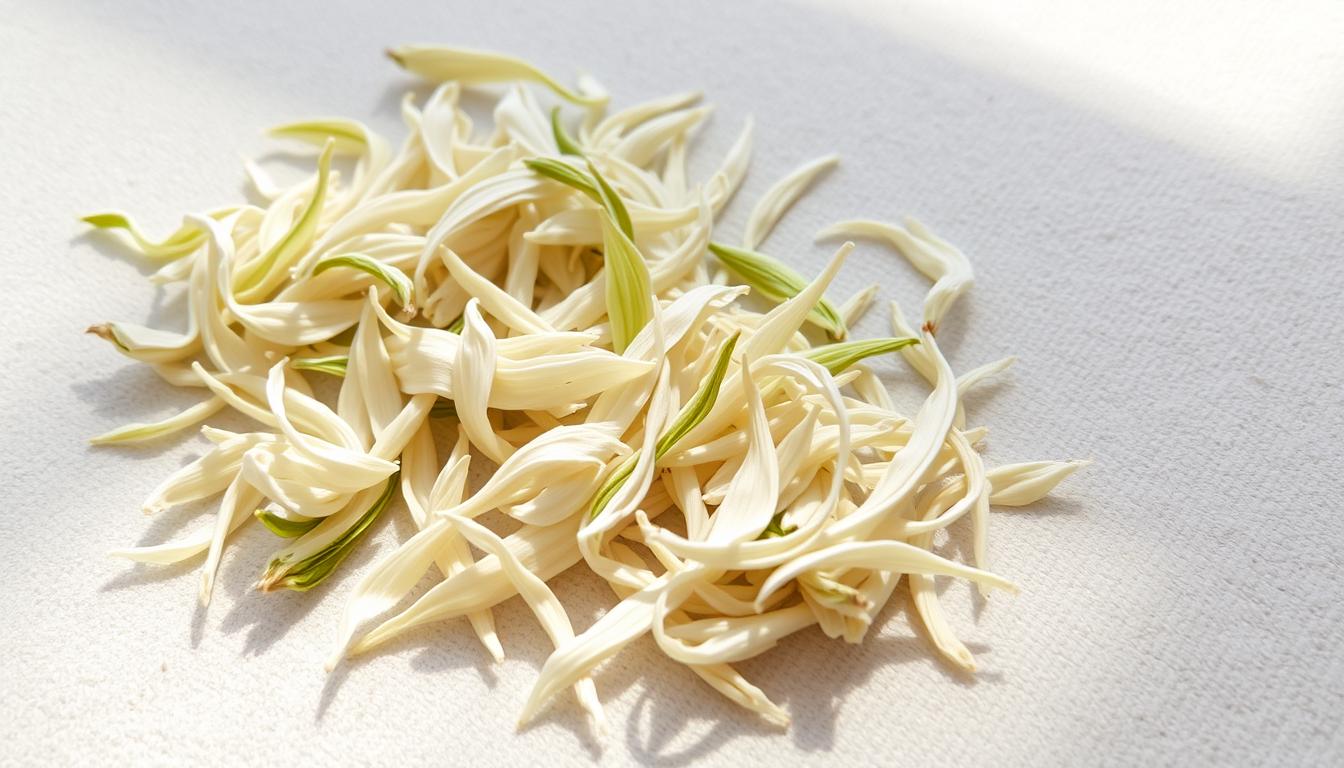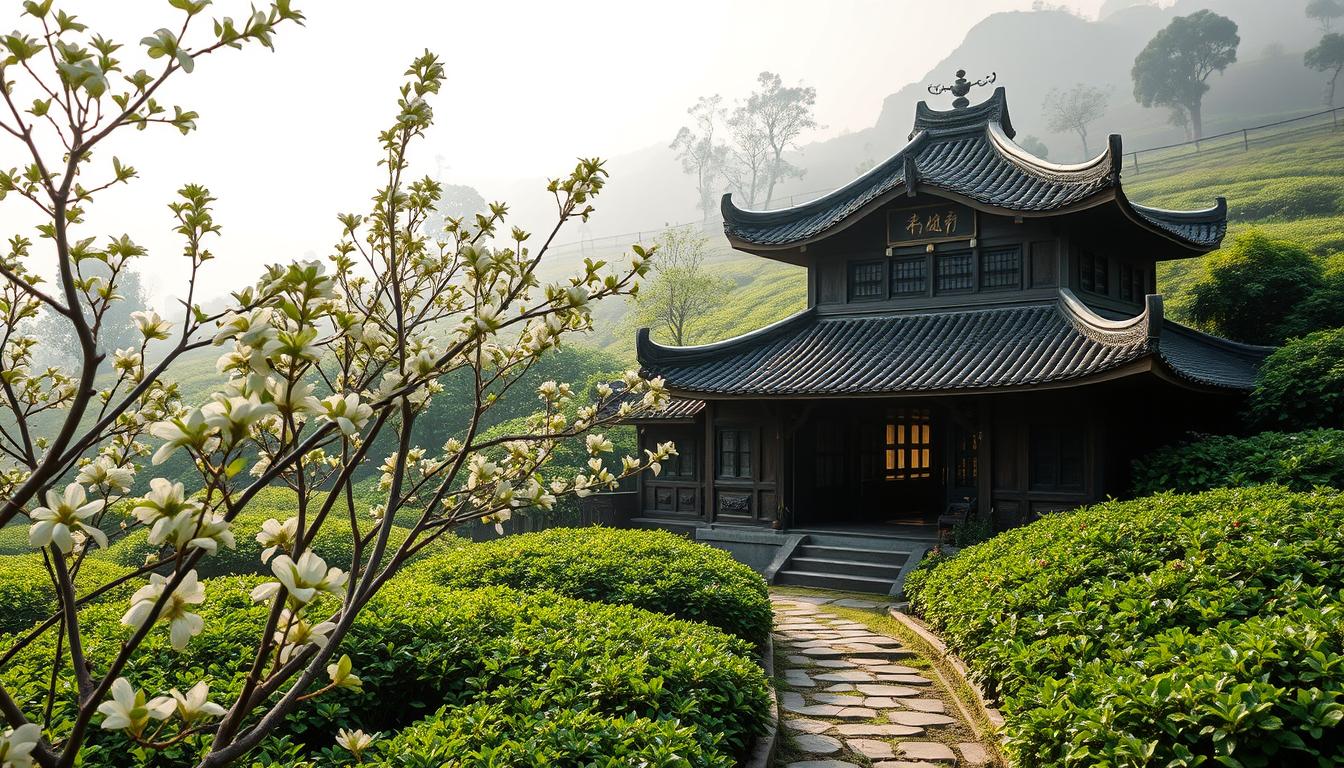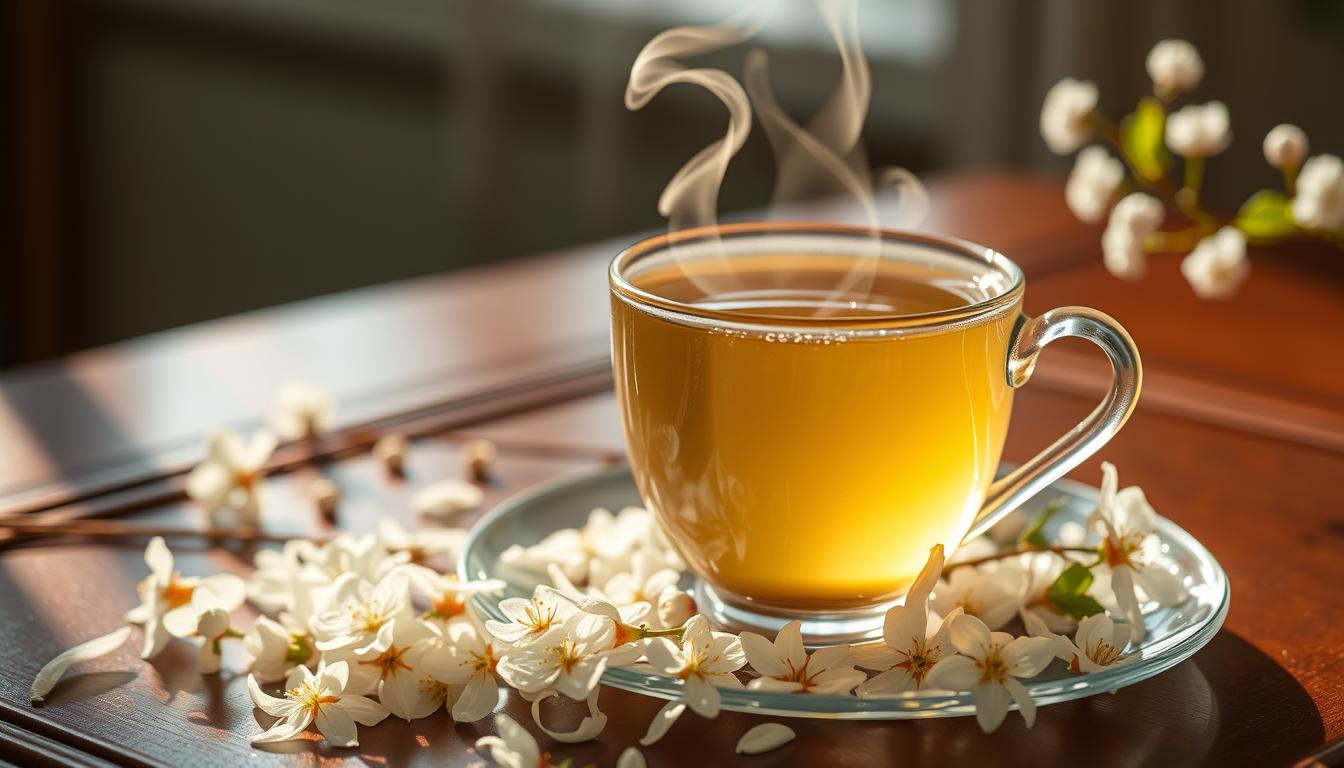What makes white tea special? It’s known for its delicate taste and health perks. This has made it a favorite among tea lovers. Its history in ancient China adds to its charm.
White tea’s gentle brew is a treat for the senses. It also tells a story of its past. We’ll look into its history, types, and health benefits. This will give you a full picture of why white tea is so loved.
Key Takeaways
- White tea is a gentle brew with a rich tradition
- It has a unique flavor profile and numerous health benefits
- White tea originated in ancient China and has evolved over time
- It is a popular choice among tea enthusiasts seeking a soothing beverage
- White tea is an integral part of Chinese culture and tradition
- Its delicate flavor and numerous benefits make it a treasure trove of experiences
Introduction to White Tea
White tea is made from the young buds of the tea plant. It’s known for its delicate flavor and health benefits. Its unique production process makes it stand out from other teas.
White tea is harvested before the buds open fully. It’s processed minimally to keep its natural antioxidants. This careful process is what makes white tea special.
The making of white tea is intricate. It requires great care to avoid damaging the tea leaves. This detail is key to its distinct flavor.
White tea is known for its light and refreshing taste. It’s a favorite among tea lovers for its unique flavor.

White tea has low caffeine and high antioxidants. It also has a delicate aroma. These qualities make it a great choice for a healthy drink.
Exploring white tea, you’ll find many types. Each has its own flavor and health benefits. Learning about these types will deepen your appreciation for white tea.
The History of White Tea
White tea has a long and interesting history. It started in ancient China during the Song Dynasty. The Chinese royal family loved it and served it at special events.
The history of white tea is linked to Chinese tea culture. This culture values tea-making and the bond between nature and humans. White tea was a luxury, given to royalty and officials. As trade grew, white tea reached other parts of the world, exciting many.
Origins of White Tea: From Ancient China to the World
Now, white tea is loved worldwide. Its history of white tea is celebrated in China. Making white tea is hard work, needing skill and care. Tea leaves are picked by hand and dried to keep their flavor and smell.

The Evolution of White Tea Through the Centuries
White tea’s production and trade have changed over time. But its cultural importance has stayed the same. In China, white tea is key in ceremonies and daily life. Its taste and smell are loved, enjoyed at weddings and business meetings.
| Time Period | Event | Impact on White Tea |
|---|---|---|
| Song Dynasty | First production of white tea | Established white tea as a luxury item |
| Ming Dynasty | Expansion of trade routes | Introduced white tea to other parts of the world |
| Present day | Global popularity of white tea | Increased demand for high-quality white tea |
The Cultural Significance of White Tea in Chinese Society
In conclusion, the history of white tea is rich and interesting. It shows the importance of this tea in Chinese tea culture. From ancient China to today, white tea is valued. It’s more than just a drink, it’s a link to tradition, nature, and community.
Types of White Tea
White tea is famous for its light taste and health perks. White peony and silver needle are top picks for their special traits. White peony, or Bai Mudan, is a favorite for its smooth and refreshing taste.
Silver needle is known for its light and sweet flavor. To spot quality white tea, look at its color, smell, and taste. Good white tea leaves are silvery-white and have a floral scent.
Exploring white tea, you might also like Shou Mei and Gong Mei. They have unique tastes and can spice up your tea collection. Knowing about different white teas helps you enjoy their special qualities.
Whether you like white peony’s classic taste or silver needle’s delicate flavor, there’s a white tea for you. White tea’s health benefits and rich taste make it a great choice for a quality tea experience.
The Process of Making White Tea
Making white tea is a detailed process that needs careful attention. It starts with plucking and harvesting. Tea leaves are picked with great care to ensure top quality. This step is key to keeping the tea’s natural taste and nutrients.
Then comes withering and drying, a delicate art. It’s all about controlling temperature and humidity. This step removes extra moisture from the leaves. It keeps the tea’s flavor fresh and prevents spoilage. White tea needs less processing than others, which helps keep its special taste and health benefits.
- Plucking and harvesting: Tea leaves are carefully selected and picked to ensure the highest quality.
- Withering and drying: Tea leaves are dried to remove excess moisture and preserve the tea’s delicate flavor.
- Minimal processing: White tea requires less processing than other types of tea, which helps to retain its unique flavor and nutritional profile.
Understanding how white tea is made shows the effort put into it. Whether you love tea or are new to it, knowing the process makes enjoying white tea even better. It’s a unique and refreshing drink that deserves our appreciation.
The Flavor Profile of White Tea
White tea is known for its delicate flavor. It has light, sweet, and floral notes. The type of tea leaves, growing conditions, and brewing time all play a role in its taste.
The taste of white tea is subtle and refined. It often has hints of fruit, floral, and honey. The flavor can vary, with some teas having more citrus or spice. To enjoy the best flavor, pay attention to brewing time to avoid bitterness.
Tasting Notes: Light, Sweet, and Floral
When brewing white tea, consider the growing conditions. Climate, soil, and altitude can change the flavor. For example, cooler climates can make the flavor more delicate, while warmer climates can make it more pronounced.
The Impact of Growing Conditions on Flavor
To get the best flavor from white tea, the brewing time is key. The ideal time can vary by tea type and personal taste. Generally, 2-3 minutes is best, as it brings out the delicate flavors without overpowering them. Using high-quality tea leaves and the right brewing time can enhance the flavor experience.
How Brewing Time Affects the Taste of White Tea
The following table summarizes the key factors that influence the flavor profile of white tea:
| Factor | Description |
|---|---|
| Type of tea leaves | Affects the flavor profile and aroma of white tea |
| Growing conditions | Influences the flavor profile and quality of white tea |
| Brewing time | Affects the flavor and aroma of white tea, with optimal brewing time varying depending on the type of tea |
By understanding these factors and optimizing the brewing technique, tea enthusiasts can fully appreciate the unique flavor profile of white tea and enjoy a truly exceptional taste experience.
The Health Benefits of White Tea
White tea is famous for its health perks, thanks to its antioxidants. These antioxidants boost the immune system. They protect the body from free radicals that harm cells and lead to diseases. White tea also helps with skin care and weight management.
White tea is great for your skin, reducing wrinkles and fine lines. Its antioxidants fight off skin damage from the environment and sun. It may also help with weight loss by boosting metabolism and fat burning.
White tea also has calming effects. Its antioxidants lower stress and improve well-being. It’s a perfect choice for a healthy, soothing drink. With its many benefits, white tea is a great part of a healthy lifestyle.
| Health Benefit | Description |
|---|---|
| Antioxidant Content | Boosts immune system, protects against cell damage |
| Skin Care Benefits | Fights aging, reduces fine lines and wrinkles |
| Weight Management | May aid in weight loss by enhancing metabolism and fat burning |
| Calm and Relaxing Effects | Reduces stress levels, promotes a sense of well-being |
How to Brew the Perfect Cup of White Tea
Brewing white tea is an art that needs careful attention. The water temperature is key to its delicate flavor and aroma. The best temperature is between 150°F and 170°F. This keeps the tea’s natural taste intact.
The brewing time is also important. It should be between 2-3 minutes, depending on your taste. Start with a shorter time to avoid bitterness. Use one teaspoon of loose-leaf tea or one bag for every 8 oz of water.
The Best Water Temperature for White Tea
Choosing the right water temperature is crucial. Water that’s too hot can burn the leaves. Water that’s too cold may not bring out the flavor. Try different temperatures to find your ideal cup.
Ideal Brewing Time: How to Avoid Over-Steeping
Watch the brewing time to avoid over-steeping. Start with a shorter time and adjust as needed. This ensures the perfect balance of flavor and aroma in your white tea.
Choosing the Right Teapot and Equipment
Invest in quality teapots and equipment for better brewing. Choose materials like ceramic or glass. They help preserve the tea’s flavor and aroma.
White Tea and Food Pairings
White tea pairings are all about finding flavors that complement its light taste. It’s perfect for a variety of foods, from sweet to savory. This makes it easy to find the right match.
Pairing white tea with fruits, nuts, and sweets is a classic choice. Its subtle flavor won’t mask the taste of these foods. Try pairing Silver Needle with strawberries and cream, or Bai Mudan with roasted almonds and dried fruit.
Creating a White Tea Afternoon Tea Menu
Here are some ideas for a white tea afternoon tea menu:
- White tea-infused sandwiches, like cucumber and cream cheese or smoked salmon
- Scones with clotted cream and jam, served with a pot of white tea
- Petit fours, such as macarons or madeleines, that match white tea’s delicate flavor
Exploring regional pairings can also be exciting. Chinese white teas go well with dim sum or traditional Chinese dishes. Trying different pairings can lead to new favorite flavors.
Adding white tea to your afternoon tea menu can refresh the traditional experience. Its delicate flavor and many pairing options make it a great choice. Whether you’re a tea lover or just starting, white tea pairings will surely impress.
| White Tea | Food Pairing |
|---|---|
| Silver Needle | Strawberries and cream |
| Bai Mudan | Roasted almonds and dried fruit |
Buying and Storing White Tea
When you’re looking to buy white tea, it’s key to find a trusted source. This way, you’ll get the best taste and smell from your tea. Look for tea shops or online stores that focus on loose-leaf teas and have many white tea options.
To make sure you’re getting real white tea, look for labels like USDA Organic or Fair Trade. Reading what other customers say can also help you understand the tea’s quality. When storing white tea, keep it away from light, heat, and moisture. Use a tight container and keep it in a cool, dry spot to keep the tea’s taste and smell.
Here are some tips for buying white tea and storing white tea:
- Buy from reputable sources that offer high-quality white tea
- Check the packaging for certifications like USDA Organic or Fair Trade
- Read reviews from other customers to get an idea of the tea’s quality
- Store the tea in an airtight container away from light, heat, and moisture
By following these tips, you can enjoy your high-quality white tea for a longer time. Always check the expiration date and store the tea right to keep it fresh and flavorful.
| Tea Variety | Storage Tips |
|---|---|
| Loose-leaf white tea | Store in an airtight container away from light and heat |
| White tea bags | Store in a cool, dry place away from moisture |
Conclusion
As we wrap up our journey into the world of white tea, it’s clear that it’s more than just a drink. It’s a celebration of nature’s wonders. With its rich history and unique taste, white tea stands out as a symbol of elegance and health.
The Unique Appeal of White Tea
White tea is special because of its delicate and complex nature. It offers a calming experience that encourages you to enjoy the moment. Its light, floral, and sweet flavors take you on a refreshing journey.
Whether you’re looking for peace or a health boost, white tea is there for you. It can make your daily life better in many ways.
How Drinking White Tea Enhances Your Lifestyle
Adding white tea to your life can change things for the better. It’s packed with antioxidants and may help with weight management. It also brings calm and relaxation.
Drinking white tea can make you more mindful. It helps you appreciate the little things in life. It’s a great way to care for yourself.

